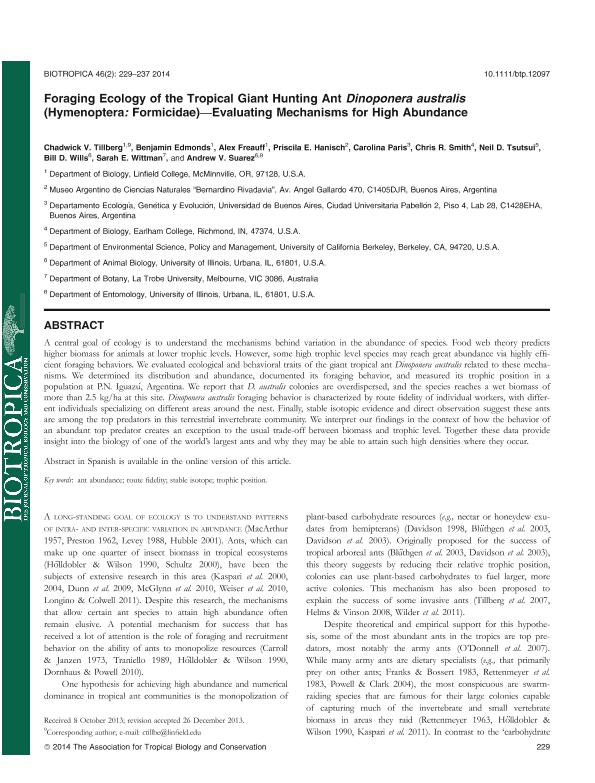Artículo
Uno de los aspectos centrales de la ecología es comprender los mecanismos que modulan la variación de la abundancia de las especies. La teoría trófica de redes predice una mayor biomasa en los niveles tróficos inferiores. Sin embargo, algunas especies de los niveles tróficos superiores son abundantes a través de su eficiencia de forrajeo. En el P. N. Iguazú, Argentina, se evaluaron ciertas características ecológicas y comportamentales de la hormiga tropical gigante Dinoponera australis, relacionadas con estos mecanismos. Se determinó su distribución y abundancia como así también, se documentó su comportamiento de forrajeo y se estimó su posición trófica. Las colonias de D. australis están sobre-dispersadas y la biomasa fresca de esta especie alcanza valores mayores a 2.5 kg/ha en el área. El comportamiento de forrajeo de D. australis está caracterizado por una alta fidelidad de los individuos a un área de forrajeo, estando algunos individuos especializados en ciertos sectores alrededor del nido. La evidencia aportada por el análisis de los isótopos estables y las observaciones directas de forrajeo sugieren que esta hormiga se encuentra entre los predadores tope de la comunidad de invertebrados terrestres. Los resultados se discuten en el contexto de cómo el comportamiento de un predador tope genera una excepción a la compensación usualmente encontrada entre biomasa y nivel trófico. En conjunto, estos resultados proveen información sobre la biología de una de las hormigas más grandes del mundo y brindan una posible explicación acerca de la alta densidad que esta especie puede alcanzar en las áreas donde ocurre. A central goal of ecology is to understand the mechanisms behind variation in the abundance of species. Food web theory predicts higher biomass for animals at lower trophic levels. However, some high trophic level species may reach great abundance via highly efficient foraging behaviors. We evaluated ecological and behavioral traits of the giant tropical ant Dinoponera australis related to these mechanisms. We determined its distribution and abundance, documented its foraging behavior, and measured its trophic position in a population at P.N. Iguazú, Argentina. We report that D. australis colonies are overdispersed, and the species reaches a wet biomass of more than 2.5 kg/ha at this site. Dinoponera australis foraging behavior is characterized by route fidelity of individual workers, with different individuals specializing on different areas around the nest. Finally, stable isotopic evidence and direct observation suggest these ants are among the top predators in this terrestrial invertebrate community. We interpret our findings in the context of how the behavior of an abundant top predator creates an exception to the usual trade-off between biomass and trophic level. Together these data provide insight into the biology of one of the world's largest ants and why they may be able to attain such high densities where they occur.
Foraging Ecology of the Tropical Giant Hunting Ant Dinoponera australis (Hymenoptera: Formicidae) - Evaluating Mechanisms for High Abundance
Tillberg, Chadwick V.; Edmonds, Benjamin; Freauff, Alex; Hanisch, Priscila Elena ; Paris, Carolina Ivon; Smith, Chris R.; Tsutsui, Neil D.; Wills, Bill D.; Wittman, Sarah E.; Suarez, Andrew V.
; Paris, Carolina Ivon; Smith, Chris R.; Tsutsui, Neil D.; Wills, Bill D.; Wittman, Sarah E.; Suarez, Andrew V.
 ; Paris, Carolina Ivon; Smith, Chris R.; Tsutsui, Neil D.; Wills, Bill D.; Wittman, Sarah E.; Suarez, Andrew V.
; Paris, Carolina Ivon; Smith, Chris R.; Tsutsui, Neil D.; Wills, Bill D.; Wittman, Sarah E.; Suarez, Andrew V.
Fecha de publicación:
03/2014
Editorial:
Wiley
Revista:
Biotropica
ISSN:
0006-3606
Idioma:
Inglés
Tipo de recurso:
Artículo publicado
Clasificación temática:
Resumen
Palabras clave:
Ant Abundance
,
Route Fidelit
,
Stable Isotope
,
Trophic Position
Archivos asociados
Licencia
Identificadores
Colecciones
Articulos(MACNBR)
Articulos de MUSEO ARG.DE CS.NAT "BERNARDINO RIVADAVIA"
Articulos de MUSEO ARG.DE CS.NAT "BERNARDINO RIVADAVIA"
Citación
Tillberg, Chadwick V. ; Edmonds, Benjamin ; Freauff, Alex ; Hanisch, Priscila Elena; Paris, Carolina Ivon; et al.; Foraging Ecology of the Tropical Giant Hunting Ant Dinoponera australis (Hymenoptera: Formicidae) - Evaluating Mechanisms for High Abundance; Wiley; Biotropica; 46; 2; 3-2014; 229-237
Compartir
Altmétricas



